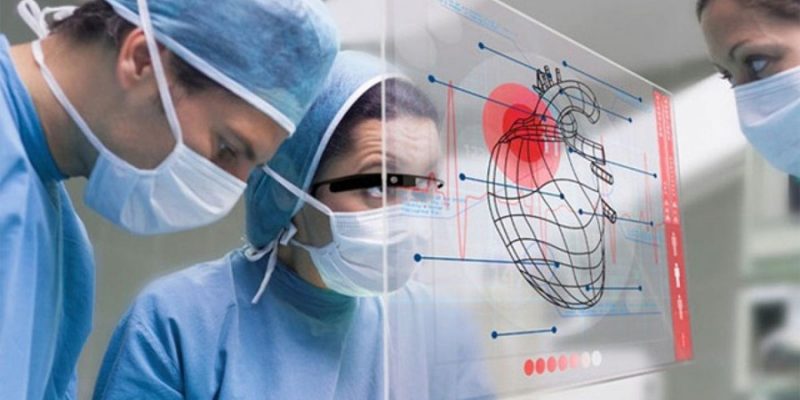
Many healthcare institutions are already utilizing virtual reality (VR) and other cutting-edge technology such as augmented reality to great effect.
Augmented reality (AR) and virtual reality (VR) in the healthcare sector are giving a new perspective to the world. Virtual reality (VR) and other innovative technologies such as augmented reality are already being used by many healthcare organizations (AR). Technologists employ virtual reality in various settings, including treating patients, medical teaching, and hospital management.
Augmented Surgery
Surgeons can utilize AR to learn more about their patients’ anatomy. They may feed their MRI and CT scan results into an AR headset. Then, just before surgery, place-specific patient physiology over their body. Doctors can examine muscles, bones, and essential organs with this technology. Previously, surgery had a significant mortality rate. Procedures can now be a lot safer because of AR. When physicians and experts try to save patients’ lives, AR can help by providing people with all the information they need. Physicians could be more aware of organ placement, vein meshes, and diagnostic reports as they operate since they are all there in front of their eyes.
Augmented Diagnosis
Some patients, you may have seen, have trouble accurately articulating actual symptoms to doctors. Because of AR, patients will finally be able to communicate their symptoms. As a result of this procedure, doctors can more readily examine their patients’ complaints and diagnose them more accurately. Using augmented reality, the nurse can now swiftly find veins. How? AccuVein, an AR firm that uses a portable scanner, allows nurses to determine the location of veins.
Augmented Practice
Medical schools use augmented reality in their curricula to give students hands-on learning opportunities. It would be simple to replicate patients and surgical interactions for students using AR in education. Medical students can use augmented reality to see and apply theories throughout their training.
Virtual Collaboration Between Physicians With AR
What if your surgeon is thousands of miles away? AR may be able to help you. If the surgeon is unavailable and a specialized on hand possesses AR tools, the specialist can assist and follow orders. Doctors may employ AR for collaborative operations and AR video conferencing for successful meetings on any health topic. With doctors from outside the clinic assisting, it might be a life-saving situation.
Help Guide New Mothers with Breastfeeding
Google Glass can assist women who are having difficulty nursing. Small World, a Melbourne-based innovation firm, collaborated with the Australian Breastfeeding Association on a Google Glass pilot. Telephone counselors were able to view through the eyes of women who were breastfeeding at home during the study. The findings might aid in the provision of professional assistance to struggling moms throughout the day. The nicest thing was that the moms didn’t have to put their newborns down.
Help Patients to Describe Their Symptoms Better
A comprehensive description of symptoms is required for a correct diagnosis. You may have observed that folks have a hard time describing their symptoms. As a result of these conditions, an inaccurate diagnosis may be made. Technology might help with patient education. EyeDecide is a medical program that uses a camera display to mimic the impact of various illnesses on a person’s eyesight. Doctors may now examine a simulation of a patient’s vision while experiencing a certain condition using applications like EyeDecide. As a consequence, individuals with Cataracts or AMD can understand their symptoms and also their present medical state.
Help Nurses Find Veins Easily
AccuVein, a start-up company, is employing augmented reality to benefit nurses and patients. How? The majority of IVs (intravenous injections) miss the vein on the first try. For youngsters and the elderly, the situation is becoming worse. AccuVein now employs augmented reality to show nurses and doctors where veins are in patients’ bodies using a portable scanner that is projected over the skin. According to AccuVein’s marketing specialist, Vinny Luciano, technology has been utilized on over 10 million patients. The AR software increases the chances of detecting a vein on a first stick by 3.5 times.
Pharma Companies Can Offer Innovative Drug Information
Consider reviewing some incomprehensible medication descriptions. Although knowing how medicine works within your body would have been interesting. How can you learn about medications while simultaneously having fun? Your solution is augmented reality. Patients may now view the drug’s action in three dimensions. How? Patients can use AR to learn more about how medications operate. Lab staff can use AR equipment to monitor their studies.
Helping Kids Learn About the Human Body
Curiscope, a firm headquartered in the United Kingdom, created the Virtuali-tee T-shirt. The firm is well-known for its immersive learning experiences. Virtual-tee brings physiology to life, making learning about the human body fascinating and fascinating for youngsters. In healthcare, there are several examples of AR. Healthcare firms will continue to benefit from augmented reality, which will improve patient care. It’s up to you to figure out new business operations and see how augmented reality can help you enhance your operations.



















